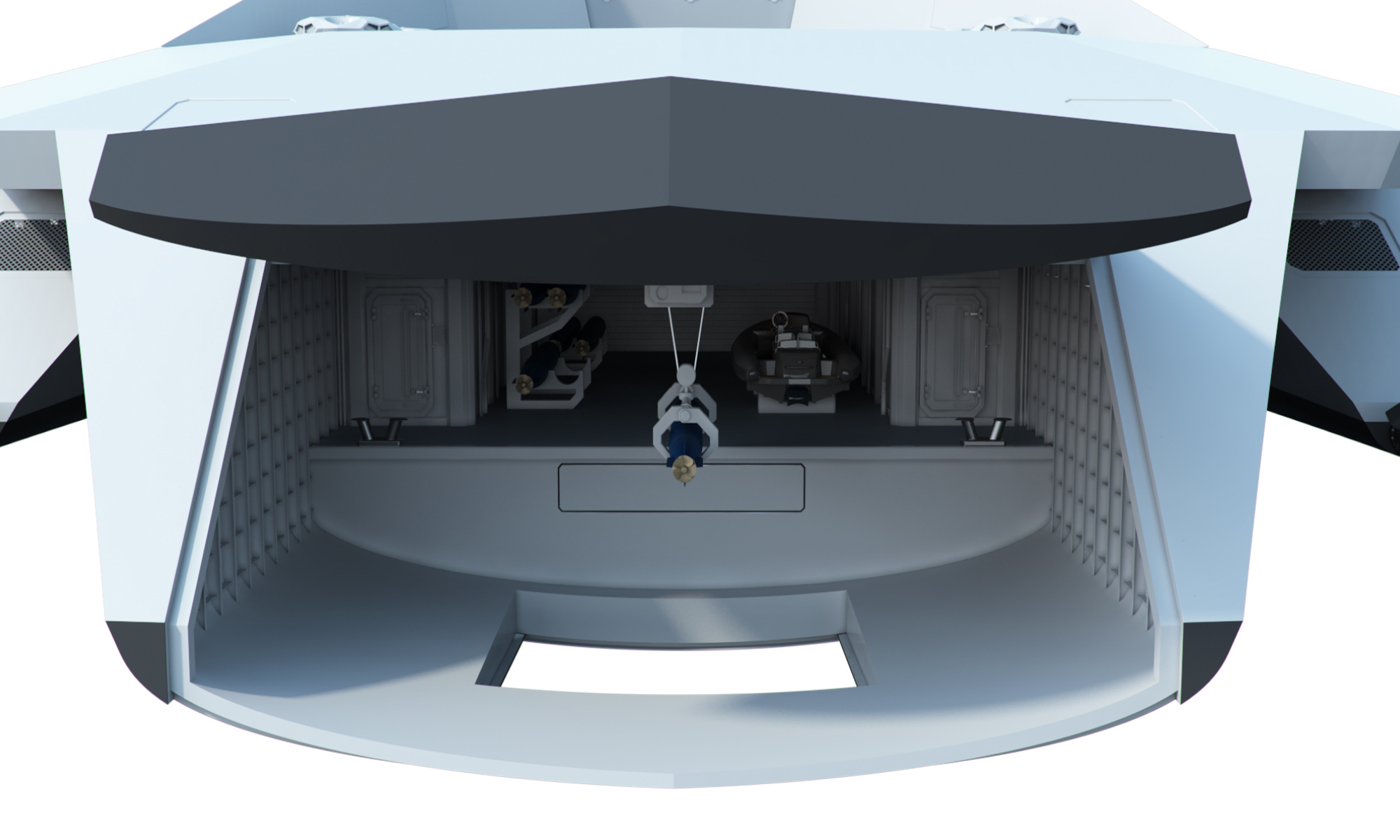
Conceptual rendering of the Startpoint T2050, aft view. Courtesy photo Startpoint
Is This the Warship of the Future?
Laser-armed battleships that print their own drones will have to survive anti-ship missiles plummeting from space.
If you thought the battleship era faded after World War II, just wait a few decades. A group of British designers with the Startpoint group have revealed concept art for a future warship called Dreadnought 2050, the product of an open-thought experiment at the informal request of the U.K. Ministry of Defense.
Named for the 1905 British man-of-war that rendered its predecessors obsolete, Dreadnought 2050 has all the futuristic accessories that a mid-21st-century warship shouldn’t be without. The ship is powered by hydrogen fusion — or if that proves unworkable, then at least by “highly efficient turbines driving silent electric motors to waterjets.” The hull is composed of “ultra-strong” composites of the finest acrylic. Out back, there’s a floodable dock for launching Royal Marines and swimming drones, a deck for launching armed aerial drones, and 3D printers to make more as needed. The designers don’t specify the size of their new dreadnought, but they imagine it would replace a ship with a crew of about 200 — perhaps making it comparable to the U.S. Navy’s 15,000-ton Zumwalt-class destroyer.

Startpoint Dreadnought 2050 concept art
The captain and crew steer and fight the ship by interacting with elaborate holograms, which, of course, looks cool. But Startpoint says the futuristic interface will allow the ship to operate with a total complement of about 100 sailors or less, including just five in the ops room.

Startpoint Dreadnought 2050 concept art
The ship is armed with an electromagnetic railgun, not so different from the one that the Office of Naval Research is building, but with 200-kilometer range, plus microwave guns to keep small enemy boats at bay. Its supercavitating torpedoes can reach speeds of 300 knots. The cherry on top is a drone that launches from where the mast should be, connected to the hull via a cryogenically cooled, carbon-nanotube tether. It’s an extension cord to power the drone’s advanced sensors and, of course, its menacing laser.

Startpoint Dreadnought 2050 concept art
“While some of these technologies push today’s boundaries in science and engineering, there is no reason why elements could not be incorporated into future designs. The Royal Navy needs visionary, innovative thinking and these concepts point the way to cutting edge technology which can be acquired at less cost and operated with less manpower than anything at sea today in the world’s leading navies,” said Muir Macdonald, a Startpoint senior executive, said in a press release.
Of course, what’s really on display here is the cutting-edge technology of the present, not the future, and all on a platform borrowed from the past. And how realistic is this vision, anyhow?
In a recent piece for The National Interest, historian Robert Farley looked back at the age of the battleship, when ships faced predictable threats—namely, other ships. In a gentlemanly one-on-one match, the question of how much armor vs. armaments to put on a hull was a straightforward cost-benefit analysis.
“The process of ensuring survivability was simplified, in these early battleships, by the predictability of the threat,” Farley wrote. “The most likely vector of attack in the late 1890s came from large naval artillery carried by other ships, and consequently protective schemes could concentrate on that threat.”
Then came submarines, aircraft, aircraft carriers, the goal of projecting power from blue water onto land, and now the prospect of anti-ship ballistic missiles that might hold at risk any surface vessel of sufficient size. Does a return to large warships make any sense?
China, which is reportedly working on an anti-ship ballistic missile, nevertheless seems to think so. Once completed, the Chinese Type 055 cruiser would stretch 160 to 180 meters and displace 12,000 to 14,000 tons of water. It will be slightly smaller than a U.S. Zumwalt-class destroyer, but will be the largest “Asian surface warship since World War II's Japanese Tone-class heavy cruisers,” Peter Singer and Jeffrey Lin write in Popular Science.
And that’s hardly the biggest warship in the sea. Russia recently announced plans to overhaul its Pyotr Veliky nuclear-powered Kirov-class battlecruiser, which displaces some 24,000 tons. That’s about as close to a World War I battleship as you get these days.
In an era of hypersonic missiles and aircraft, what possible advantage could this type of platform still have? Farley said the simple answer is power — as in electricity: “The most interesting innovations in naval technology involve sensors, unmanned technology, lasers, and railguns, most of which are power intensive. Larger ships can generate more power, increasing not only their lethality (rail guns, sensors) but also their survivability (anti-missile lasers, defensive sensor technologies, close-defense systems).”
In other words, warships have a future because we will keep inventing things to put on them.
If laser weapons can evolve fast enough to fight off hypersonic ballistic and cruise missiles, large ships may still be relevant in 2050. Then there’s just diesel-electric stealth submarines and thousand-dollar naval mines to worry about.





